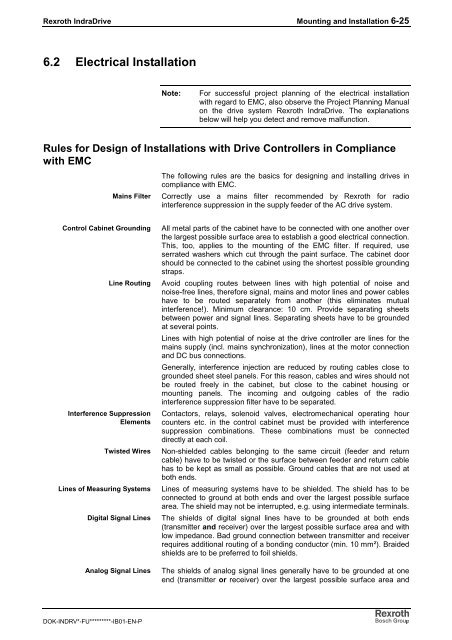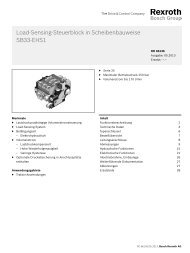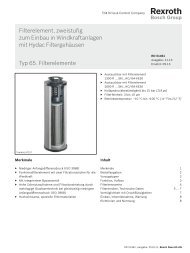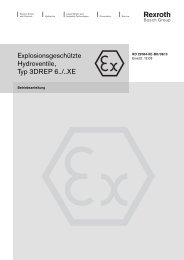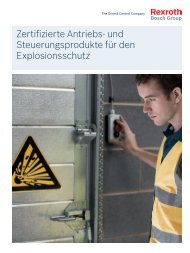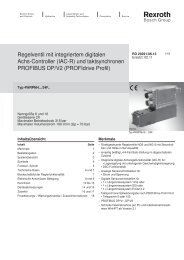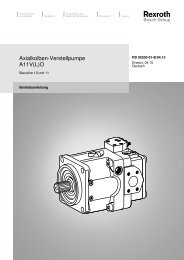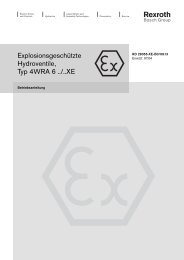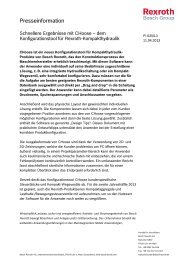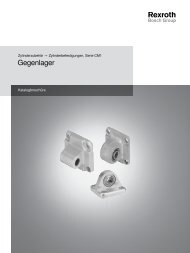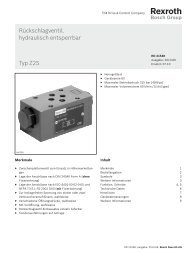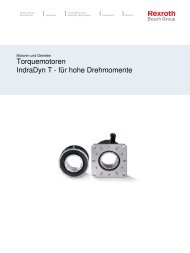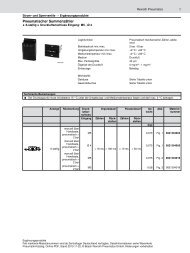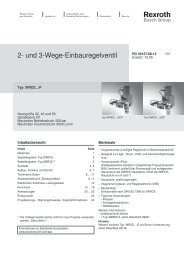Rexroth IndraDrive C Drive Controllers HCS02.1 ... - Bosch Rexroth
Rexroth IndraDrive C Drive Controllers HCS02.1 ... - Bosch Rexroth
Rexroth IndraDrive C Drive Controllers HCS02.1 ... - Bosch Rexroth
Create successful ePaper yourself
Turn your PDF publications into a flip-book with our unique Google optimized e-Paper software.
<strong>Rexroth</strong> <strong>Indra<strong>Drive</strong></strong> Mounting and Installation 6-25<br />
6.2 Electrical Installation<br />
DOK-INDRV*-FU*********-IB01-EN-P<br />
Note: For successful project planning of the electrical installation<br />
with regard to EMC, also observe the Project Planning Manual<br />
on the drive system <strong>Rexroth</strong> <strong>Indra<strong>Drive</strong></strong>. The explanations<br />
below will help you detect and remove malfunction.<br />
Rules for Design of Installations with <strong>Drive</strong> <strong>Controllers</strong> in Compliance<br />
with EMC<br />
Mains Filter<br />
Control Cabinet Grounding<br />
Line Routing<br />
Interference Suppression<br />
Elements<br />
Twisted Wires<br />
Lines of Measuring Systems<br />
Digital Signal Lines<br />
Analog Signal Lines<br />
The following rules are the basics for designing and installing drives in<br />
compliance with EMC.<br />
Correctly use a mains filter recommended by <strong>Rexroth</strong> for radio<br />
interference suppression in the supply feeder of the AC drive system.<br />
All metal parts of the cabinet have to be connected with one another over<br />
the largest possible surface area to establish a good electrical connection.<br />
This, too, applies to the mounting of the EMC filter. If required, use<br />
serrated washers which cut through the paint surface. The cabinet door<br />
should be connected to the cabinet using the shortest possible grounding<br />
straps.<br />
Avoid coupling routes between lines with high potential of noise and<br />
noise-free lines, therefore signal, mains and motor lines and power cables<br />
have to be routed separately from another (this eliminates mutual<br />
interference!). Minimum clearance: 10 cm. Provide separating sheets<br />
between power and signal lines. Separating sheets have to be grounded<br />
at several points.<br />
Lines with high potential of noise at the drive controller are lines for the<br />
mains supply (incl. mains synchronization), lines at the motor connection<br />
and DC bus connections.<br />
Generally, interference injection are reduced by routing cables close to<br />
grounded sheet steel panels. For this reason, cables and wires should not<br />
be routed freely in the cabinet, but close to the cabinet housing or<br />
mounting panels. The incoming and outgoing cables of the radio<br />
interference suppression filter have to be separated.<br />
Contactors, relays, solenoid valves, electromechanical operating hour<br />
counters etc. in the control cabinet must be provided with interference<br />
suppression combinations. These combinations must be connected<br />
directly at each coil.<br />
Non-shielded cables belonging to the same circuit (feeder and return<br />
cable) have to be twisted or the surface between feeder and return cable<br />
has to be kept as small as possible. Ground cables that are not used at<br />
both ends.<br />
Lines of measuring systems have to be shielded. The shield has to be<br />
connected to ground at both ends and over the largest possible surface<br />
area. The shield may not be interrupted, e.g. using intermediate terminals.<br />
The shields of digital signal lines have to be grounded at both ends<br />
(transmitter and receiver) over the largest possible surface area and with<br />
low impedance. Bad ground connection between transmitter and receiver<br />
requires additional routing of a bonding conductor (min. 10 mm²). Braided<br />
shields are to be preferred to foil shields.<br />
The shields of analog signal lines generally have to be grounded at one<br />
end (transmitter or receiver) over the largest possible surface area and


